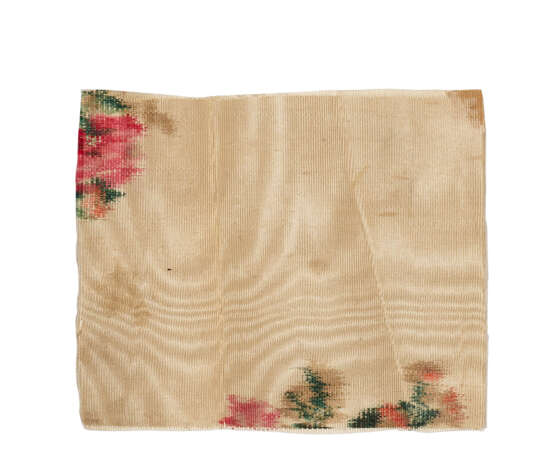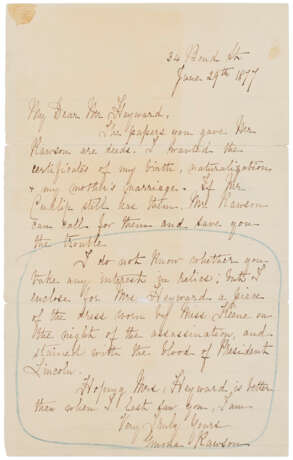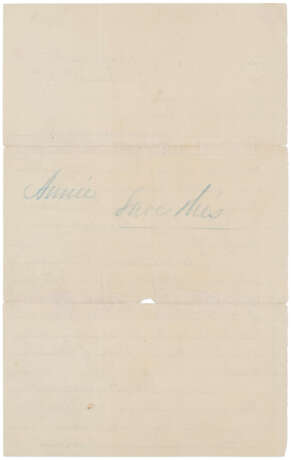ID 1033001
Lot 341 | A piece of her costume worn the night of Lincoln's assassination
Estimate value
$ 8 000 – 12 000
(LINCOLN ASSASSINATION) – [Laura KEENE (1826-1873)]. A swatch of fabric from her costume worn the night of 14 April 1865 at Ford's Theatre. [With:] RAWSON, Emma Eliza Taylor (1844-1882). Autograph letter signed ("Emma Rawson") to "My Dear Mr. Heyward," [New York,] 20 June 1877. [Also with:] former enclosing envelope bearing the printed return address for "The Hayward Company, 50 Church Street, New York, N.Y."
92 x 75mm, swatch of off white silk with ikat rose design (some fraying at edges). Letter: 205 x 127mm (horizontal fold separation repaired on verso). Envelope: 95 x 170mm (recto and verso separated).
A piece of Laura Keene’s Dress worn the night of Abraham Lincoln’s assassination at Ford's Theatre replete with stains from her time spent Lincoln’s box at attending to the mortally-wounded President. Laura Keene, an English-born actress and theatrical manager, was playing the starring role of Florence Trenchard in the hit comedy, Our American Cousin on the evening of 14 April 1865. That evening was a farewell performance for Miss Keene, who had been engaged at Ford's Theatre for the past two weeks, playing a variety of roles to packed houses. The night of the 14th was the final night of her run. But what was to be a triumphant benefit evening performance for Miss Keene was suddenly interrupted during the second scene of the third act by a gunshot from none other than the great actor Edwin Booth's brother, John Wilkes Booth.
Keene was in the wings awaiting a cue when she heard the shot, after recovering from her shock, made her way to the Presidential box, where, according to Dr. Charles A. Leale, who attended to the mortally wounded Lincoln, found Miss Keene in the box on his arrival, and she "appealed to me to allow her to hold the President's head. I granted this request and she sat on the floor of the box and held his head on her lap." (Charles A. Leale, Lincoln's Last Hours, [n.p., n.d.] pp. 3-4.) Jennie Gourlay, who was playing Mary Trenchard in the play, wrote that Keene raised Lincoln's head "in her arms and found blood trickling down her dress." (Letter, 28 April 1923, quoted in Allen C. Clark, Abraham Lincoln in the National Capital (1925) 107) Later that evening, a Washington attorney, Seaton Munroe, was approaching the theatre after hearing the terrible news when he encountered Keene on Pennsylvania Avenue: "Her hair and dress were in disorder, and not only was her gown soaked with Lincoln's blood, but her hands, even her cheeks where her fingers had strayed were bedaubed with the sorry stains." (Seaton Munroe, "Recollections of Lincoln's Assassination" North American Review, Vol. 162 (April 1896) 425.) Others have cast doubt on Keene's claims. None of the eyewitness who testified in the trial of the conspirators mentioned seeing her in the box that night, while others have noted that nearly all the accounts placing Keene in the box were given decades after the event. For most comprehensive scholarship on Laura Keene's whereabouts on the night of 14 April 1865, see: Billy J. Harbin, "Laura Keene at the Lincoln Assassination," Educational Theatre Journal, Vol. 18, No. 1 (Mar. 1966), pp. 47-54.
The present example was presented by Laura Keene's daughter, Emma Rawson, to the wife of a "Mr. Heyward [sic, likely Hayward]," who had assisted with obtaining several legal documents for her. In the accompanying letter, she writes that she was unaware "whether you take any interest in relics; but I enclose for Mrs. Heyward, a piece of the dress worn by Miss Keene on the night of the assassination, and stained with the blood of President Lincoln." On the verso of the letter, someone has implored "Annie," in blue pencil to "Save this." The letter and swatch were housed in an envelope bearing the return address of the Hayward Company, which had been established in the 1850s as a manufacturer of rubber goods, later expanding into construction equipment by the early part of the last century. At some point in the 1950s or 1960s it came into the possession of a Brooklyn attorney and has passed down to the present consignor.
Rare. Including the present example, there are ten fragments from Keene's clothing worn the night of 14 April 1865 extant, and of those, five reside in institutional collections including the Abraham Lincoln Presidential Library, (Springfield, IL), The New York State Military Museum (Saratoga Springs, NY) The Chicago History Museum, The Lincoln Financial Foundation (Fort Wayne, IN), and the Smithsonian Institution. Provenance: Laura Keene — (inherited by) Emma Rawson — (presented to) Mrs. Hayward — a Brooklyn attorney — (by descent to) the consignor.
| Artist: | Laura Keene (1826 - 1873) |
|---|
| Artist: | Laura Keene (1826 - 1873) |
|---|
| Address of auction |
CHRISTIE'S 20 Rockefeller Plaza 10020 New York USA | ||||||||||||||
|---|---|---|---|---|---|---|---|---|---|---|---|---|---|---|---|
| Preview |
| ||||||||||||||
| Phone | +1 212 636 2000 | ||||||||||||||
| Fax | +1 212 636 4930 | ||||||||||||||
| Conditions of purchase | Conditions of purchase | ||||||||||||||
| Shipping |
Postal service Courier service pickup by yourself | ||||||||||||||
| Payment methods |
Wire Transfer | ||||||||||||||
| Business hours | Business hours
|





